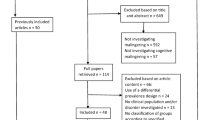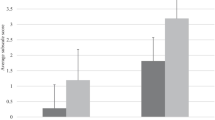Abstract
The vulnerability of competency to stand trial instruments to malingering was previously unexamined. In this study, the Georgia Court Competency Test (GCCT) was administered to offenders asked to feign incompetency; their results were compared to controls and pretrial defendants (both competent and incompetent). Offenders appeared to be able to simulate incompetency and tended to score lower on the GCCT than their truly incompetent counterparts. For the detection of simulators, a newly developed Atypical Presentation scale for the GCCT showed promise. In addition, several strategies were explored that included simulators' failure of very simple items (i.e., floor effect) and variable success on items of increasing difficulty (i.e., performance curve). Optimal cutting scores are presented for forensic clinicians to screen defendants for feigned incompetency.
Similar content being viewed by others

References
American Bar Association. (1989).ABA criminal justice mental health standards. Washington: author.
Bagby, R. M., Nicholson, R. A., Rogers, R., & Nussbaum, D. (1992). Domains of competency to stand trial.Law and Human Behavior, 16, 491–507.
Barnard, G. W., Thompson, J. W., Jr., Freeman, W. C., Robbins, L., Gies, D., & Hankins, G. C. (1991). Competency to stand trial: Description and initial evaluation of a new computer-assisted assessment tool (CADCOMP).Bulletin of the American Academy of Psychiatry and Law, 19, 367–381.
Beaber, J. R., Marston, A., Michelli, J., & Mills, M. J. (1985). A brief test for measuring malingering in schizophrenic individuals.American Journal of Psychiatry, 142, 1478–1481.
Golding, S., Roesch, R., & Schreiber, J. (1984). Assessment and conceptualization of competency to stand trial: Preliminary data on the Interdisciplinary Fitness Interview.Law and Human Behavior, 8, 321–334.
Gothard, S., Viglione, D. J., Jr., Meloy, J. R., & Sherman, M. (in press). Detecting malingering in competency to stand trial evaluations.Law and Human Behavior.
Grisso, T. (1986).Evaluating competencies: Forensic assessments and instruments. New York: Plenum.
Gudjonsson, G. H., & Shackleton, H. (1986). The pattern of scores on Raven's Matrices during “faking bad” and “nonfaking” performance.British Journal of Clinical Psychology, 25, 35–41.
Johnson, W. G., & Mullett, N. (1987). Georgia Court Competency Test-R. In M. Hersen & A. S. Bellack (Eds.),Dictionary of behavioral assessment techniques (p. 234). New York: Pergamon.
McGarry, A. L. (1973).Competency to stand trial and mental illness (DHEW Pub. No. ADM-77-103). Rockville, MD: Department of Health, Education, and Welfare.
Nicholson, R. A., & Kugler, K. E. (1991). Competent and incompetent criminal defendants: A quantitative review of comparative research.Psychological Bulletin, 109, 355–370.
Nicholson, R. A., Briggs, S. R., & Robertson, H. C. (1988). Instruments for assessing competency to stand trial: How do they work?Professional Psychology: Research and Practice, 19, 383–394.
Nicholson, R. A., Robertson, H. C., Johnson, W. G., & Jensen, G. (1988). A comparison of instruments for assessing competency to stand trial.Law and Human Behavior, 12, 313–321.
Roesch, R., Webster, C. D., & Eaves, D. (1984).The Fitness Interview Test: A method for examining fitness to stand trial. Toronto: Research Report, Center of Criminology, University of Toronto.
Rogers, R. (Ed.) (1988).Clinical assessment of malingering and deception. New York: Guilford.
Rogers, R. (1990). Development of a new classificatory model of malingering.Bulletin of the American Academy of Psychiatry and Law, 18, 323–333.
Rogers, R., Bagby, R. M., & Gillis, J. R. (1992). Improvements in the M test as a screening measure for malingering.Bulletin of the American Academy of Psychiatry and Law, 20, 101–104.
Rogers, R., Bagby, R. M., & Dickens, S. E. (1992).Structured Interview of Reported Symptoms (SIRS) and professional manual. Odessa, FL: Psychological Assessment Resources.
Rogers, R., Sewell, K. W., & Goldstein, A. (1994). Explanatory models of malingering: A prototypical analysis.Law and Human Behavior, 18, 543–552.
Rogers, R., Harrell, E. H., & Liff, C. D. (1993). Feigning neuropsychological impairment: A critical review of methodological and clinical considerations.Clinical Psychology Review, 13, 255–274.
Rogers, R., & Resnick, P. J. (1988).Training guide on assessment of malingering and deception. New York: Guilford.
Rogers, R., Sewell, K. W., & Salekin, R. (1994). A meta-analysis of malingering on the MMPI-2.Assessment, 1, 227–237.
Wildman, R., Batchelor, E., Thompson, L., Nelson, F., Moore, J., Patterson, M., & de Laosa, M. (1980),The Georgia court competency test: An attempt to develop a rapid, quantitative measure for fitness for trial. Unpublished manuscript, Forensic Services Division, Central State Hospital, Milledgeville, GA.
Author information
Authors and Affiliations
About this article
Cite this article
Gothard, S., Rogers, R. & Sewell, K.W. Feigning incompetency to stand trial. Law Hum Behav 19, 363–373 (1995). https://doi.org/10.1007/BF01499137
Issue Date:
DOI: https://doi.org/10.1007/BF01499137



